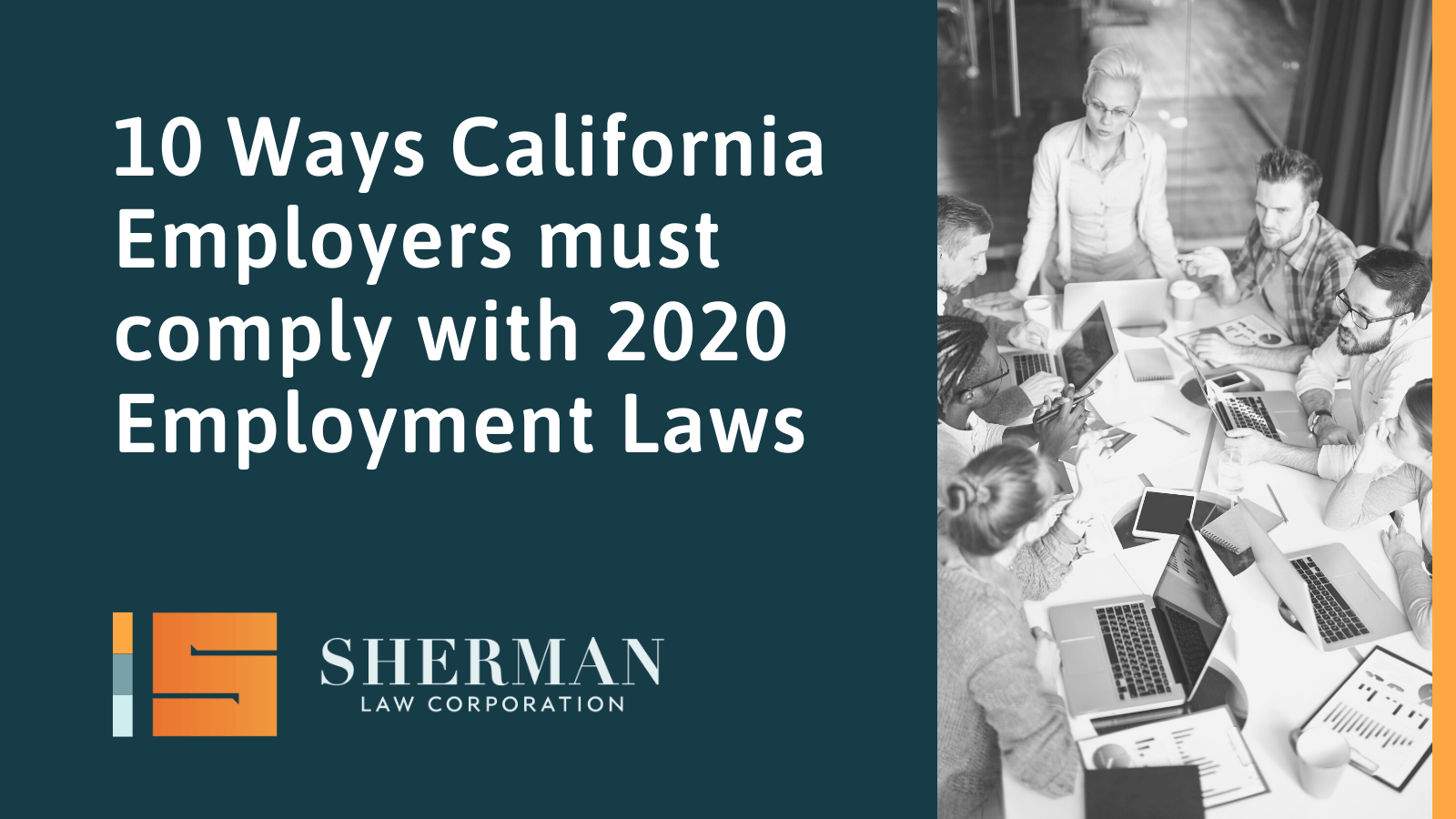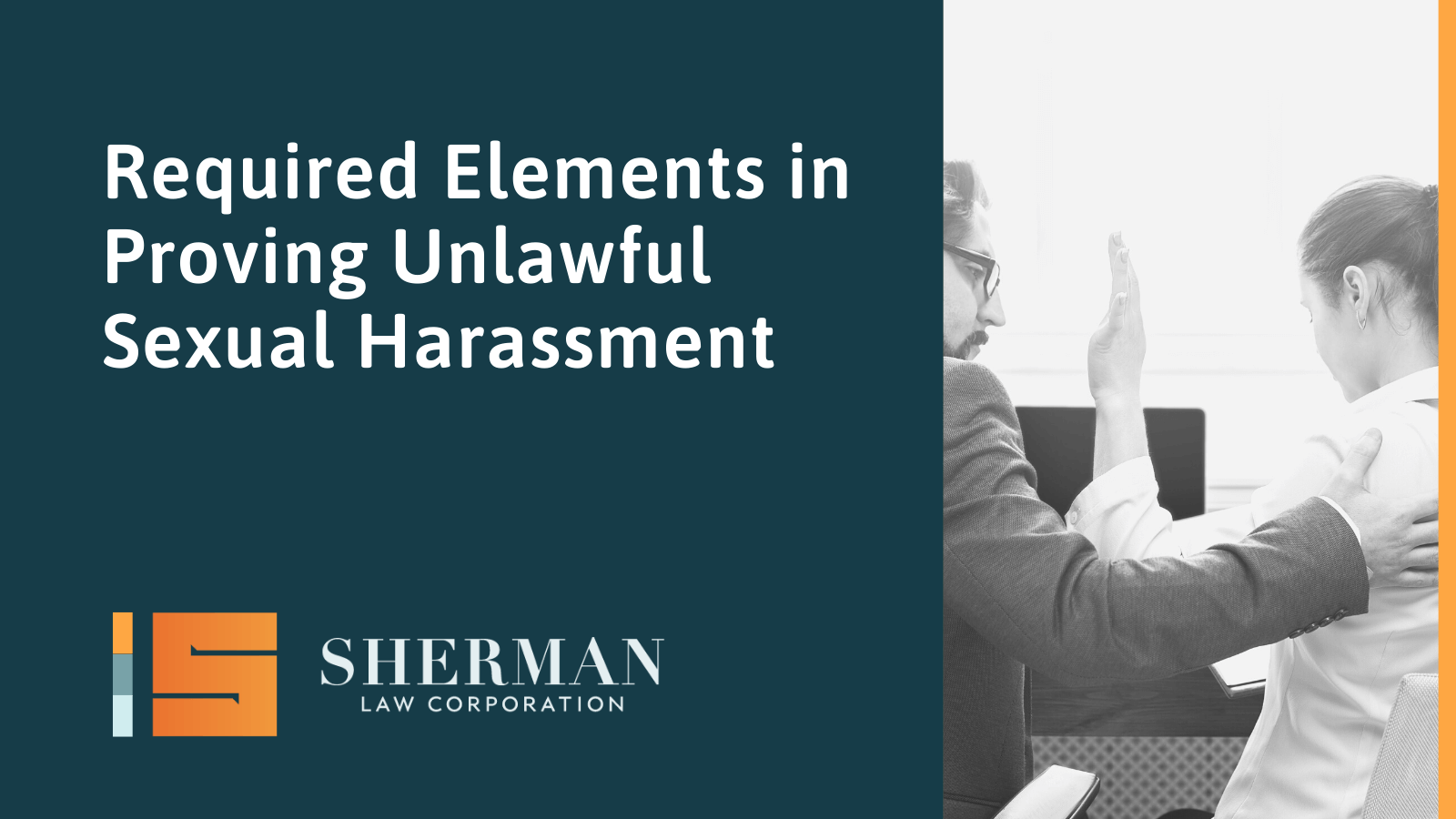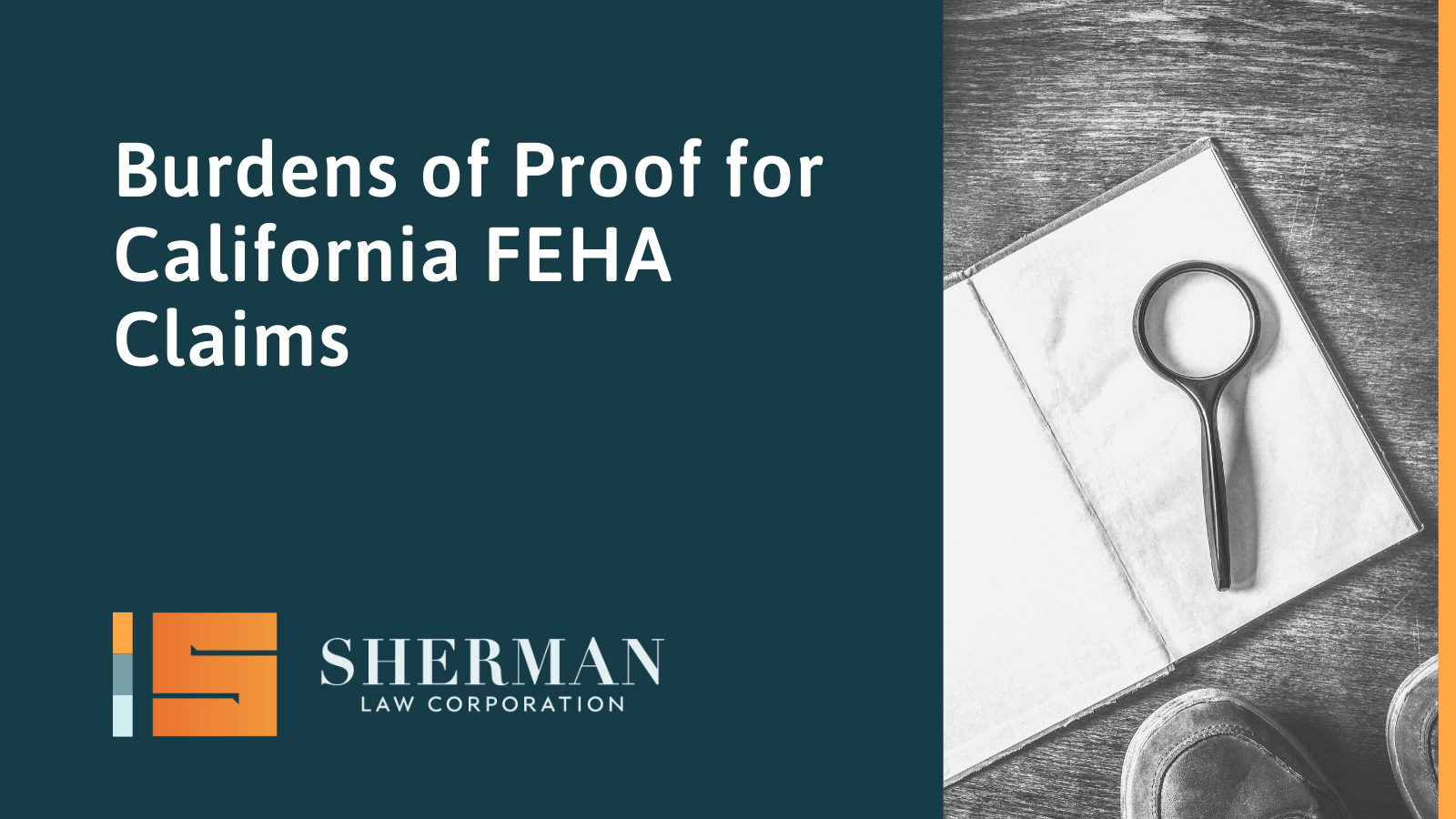
California’s Governor Gavin Newsom ended his first year in office by signing nearly 900 new laws, including many which establish new labor and employment related requirements for California employers, which became effective on January 1, 2020, unless indicated otherwise.
Below are the top ten actions California employers must take to comply with these new employment laws:
Audit the Use of Independent Contractors to Comply with AB 5
In April 2018, the California Supreme Court issued a significant decision as to the classification of workers as independent contractors in a case entitled, Dynamex Operations West, Inc. v. Superior Court of Los Angeles, 4 Cal.5th (903) (2018). The Dynamex decision created an “ABC Test” for determining whether a worker is properly classified as an independent contractor under California law.
On September 18, 2019, Governor Newsom signed into law AB 5 which, in pertinent part, created California Labor Code Section 2750.3 effective January 1, 2020. AB 5 expands the “ABC Test” to essentially all employment entitlements (not just those under the Wage Orders), and AB 5 establishes that workers are “employees” by default. To rebut this default setting, employers must pass the “ABC Test” by demonstrating that all of the following conditions are met:
- The person is free from the control and direction of the hiring entity in connection with the performance of the work, both under the contract for the performance of the work and in fact.
- The person performs work that is outside the usual course and scope of the hiring entity’s business.
- The person is customarily engaged in an independently established trade, occupation, or business of the same nature as that involved in the work performed.
Employers are likely quite familiar with the “A” and “C” parts of the “ABC Test” since those are quite similar to the “Borello” test that was widely applied in California before Dynamex. The “B” part of the new test is what likely causes many current independent contractors to now be misclassified under the new law. The most critical component is that the worker must perform work that is different than the typical work provided by the hiring entity.
For example, it would be improper for a taxi cab service to have a “taxi cab driver” classified as an independent contractor. AB 5, however, does create several exceptions for a variety of professions, and more exceptions are in the works as well (just last week, truckers were exempted temporarily from AB 5 by a Court). Some of the notable professions exempted from AB 5 include licensed insurance agents, certain health care professionals, attorneys, accountants, direct salespersons, commercial fishermen, and workers providing licensed barber or cosmetology services. AB 5 also recognizes properly established “Business to Business” contracting relationships, “Referral Agencies,” and other exceptions to the “ABC Test.”
ACTION #1:
The new law is still being challenged and interpreted. In the meantime, California businesses should audit their current Independent Contractor relationships to determine if there is an applicable exception. If an exception is not available, then the business should determine whether the worker should be converted to an employee, or if there is another lawful business arrangement that can be established. Businesses should also update any template Independent Contractor Agreements drafted prior to AB 5 so that it is clear that the contractor does in fact pass the ABC Test, and/or falls into one of the many exceptions recognized under AB 5.
Analyze use of, and update, Mandatory Arbitration Agreements:
Under AB 51, employers can no longer require job applicants, current employees, and independent contractors to arbitrate claims under the Fair Employment and Housing Act (generally, discrimination, harassment, and/or retaliation claims) and the Labor Code as a condition of employment or continued employment (or a condition of receiving any employment-related benefit). The law will apply to agreements entered into, amended, or extended on or after January 1, 2020. Significantly, this new law does NOT apply to negotiated severance agreements, or to post-dispute settlement agreements.
Like AB 5, AB 51 has received significant media attention, but the enforceability of the new law is in doubt. A year ago, former Governor Brown vetoed a similar bill. Furthermore, federal law does not share the same hostility towards arbitration agreements exhibited by California. In fact, AB 51 recognizes this tension by including language that the new law is not intended to invalidate a written arbitration agreement that is otherwise enforceable under the Federal Arbitration Act. On December 30, 2019, a federal court in Chamber of Commerce of the United States, et al. v. Becerra, et al., temporarily enjoined (prevented) the State of California from enforcing the prohibition of arbitration agreements under AB 51. The motion for a preliminary injunction is set for a hearing on January 10, 2020 – so we will await the result.
ACTION #2:
In the meantime, California employers should revisit whether they want to implement, or continue to require, mandatory arbitration. If a California employer wishes to continue to use mandatory arbitration agreements, such agreements should be updated to conform with AB 51 (and/or subsequent Court decisions and amendments). If not already done so, California employers should make the agreement enforceable under the Federal Arbitration Act which is a course of action that has long been a best practice in California, but is highlighted by AB 51 and challenges to it.
Update location, procedures, and Employee Handbook provisions regarding Lactation Accommodation:
SB 142 expands and amends prior law in regard to providing employees with lactation accommodations. The new provisions clarify that an employee is entitled to a break for each time needed to express milk. They also provide more specifics about the room or location employees are entitled to use to express milk (including a room that is safe and clean, has a surface to place a breast pump and personal items, has electricity, and that the employer must provide access to a sink with running water and a refrigerator or another cooling device suitable for storing milk). The new provisions also contain a process for employers with 50 or fewer employees to claim that compliance is an undue burden. Finally, the law makes clear that employers must include certain information in an Employee Handbook and/or other notices to employees.
ACTION #3:
Employers must update Employee Handbook provisions and/or other notices provided to employees so as to comply with Labor Code Section 1031 Employers also must evaluate and designate a location that is compliant with the requirements of the Labor Code, or if the employer has less than 50 employees, determine whether such compliance constitutes an undue burden as allowed under Section 1031.
Delete "No Rehire" provisions in certain Settlement Agreements:
Beginning January 1, 2020, “no rehire” provisions are prohibited in any settlement agreement related to any employment dispute. Significantly, if the employer has made a good faith determination that the person engaged in sexual harassment or sexual assault, then the employer can refuse to rehire the person. AB 749 adds new Code of Civil Procedure 1002.5.
ACTION #4:
California employers should delete “No Rehire” provisions from template Settlement Agreements concerning employment disputes. Employers should also consider whether they wish to retain such provisions in cases involving sexual harassment or sexual assault.
Update definition of "Race” to Prohibit Discrimination related to Hairstyles
SB 188 amends the definition of “race” under FEHA to include “traits historically associated with race, including, but not limited to, hair texture and protective hairstyles.” Protective hairstyles include “such hairstyles as braids, locks, and twists.” Notably, policies and procedures regarding health and safety related to hair styles, use of hairnets, helmets, etc. can still be enforced regardless of hairstyle.
ACTION #5:
Update Employee Handbook provisions and any other policies that include “race” discrimination and harassment to include “traits historically associated with race, including but not limited to, hair texture and protective hairstyles.” Train supervisors on the extended definition.
Amend Document Retention Policies and Practices Due to Significant Increase in Statute of Limitations on Harassment, Discrimination and Retaliation Claims under California’s Fair Employment and Housing Act.
Under prior law, the statute of limitations to bring a discrimination, harassment or retaliation claim under the California Department of Fair Employment and Housing (DFEH) was 1 year from the alleged events. AB 9 triples the statute of limitations period to 3 years which is significant. Former Governor Brown vetoed a similar bill recognizing the value of timely resolving disputes, and the potential loss of evidence and witnesses when claims are not timely prosecuted. Governor Newsom, however, disagreed which has the real possibility of exposing employers to defending older claims, that is reliant on testimonial evidence that will be based on fading witness memories and potential lost documentation if not preserved. This is particularly true because a plaintiff still has the additional 1 year (so a total of 4 years) to pursue DFEH claims in court.
ACTION #6:
Employers must combat loss of crucial evidence due to the expanded statute of limitations period by reviewing and updating their record retention policies, as well as practices and policies of documenting evidence at the time of an incident, including the gathering and preserving of witness statements, electronic evidence, videos, social media posts, text messages and all other records dating back at least four years.
Expanded Organ Donation Leave entitlements for California Employers with 15 or More Employees.
Under prior law, employers with 15 or more employees were required to provide eligible employees with 5 days of paid leave for bone marrow donation, and 30 days of paid leave for organ donation.; Starting in 2020, AB 1223, expands leave for organ donation. Specifically, employers are now required to provide a maximum of 30 business days of unpaid leave in addition to the original 30 days of paid leave in a single year.
ACTION #7:
Employers should update Employee Handbook provisions regarding organ donation leave, as well as any other notices or documents the employer provides regarding organ donation leave. Managers/supervisors, and HR administrators should also be trained to understand the new law as well.
Audit Wage Rates.
In 2020, the California minimum wage increases to $13.00/hour for employers with more than 26 or more employees, and to $12.00/hour for employers with 25 or fewer employees. The increased statewide minimum wages also increase the “salary basis test” for many “exempt” employees. Thus, in 2020, the annual salary threshold will increase to $54,080 for larger employers, and $49,920 for employers with 25 or less employees. These thresholds are much higher than the newly adopted federal threshold, so do not rely solely on federal law.
ACTION #8:
Employers should audit their wage rates to ensure that employees are paid at or higher than the applicable minimum wage and the exempt salary wage rates, and that new wage rates are accurately reflected in itemized wage statements. Employers should also be aware of any local or county/city minimum wage rates as those may be higher than the statewide minimum wage.
Expansion of Paid Family Leave.
SB 83 provides that California PFL “wage replacement” benefit (not a “time off” benefit) will increase from 6 weeks to 8 weeks per year. The new law also establishes a task force to develop a proposal to increase paid family leave wage replacement benefits to 6 months by 2021-22 for parents to care for, and bond with their newborn or newly adopted child.
ACTION #9:
Update handbooks and inform employees of the PFL changes.
Conduct Sexual Harassment Prevention Training by January 1, 2021.
Employers with 5-49 employees were originally required to implement sexual harassment prevention training for managers and employees by January 1, 2020. SB 778 extended the training deadlines by 1 year, to January 1, 2021. California employers who already complied in 2019, need not repeat the training until sometime in 2021. Note however, there are still requirements for new managers and new hires, as well as temporary employees. There are additional new laws on additional employment topics, and also for specific industries as well, including public sector employees, construction, contractors, and more.
ACTION #10:
Retain experienced Employment Counsel to Conduct Harassment Training prior to January 1, 2021.




